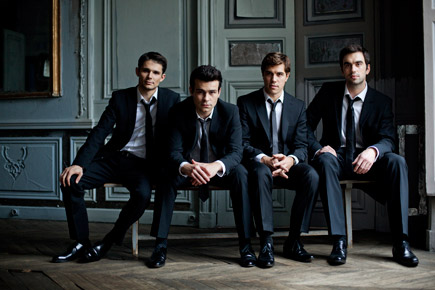Modigliani Quartet has an uneven outing at Four Arts in Palm Beach

The Modigliani Quartet performed Sunday at the Society of the Four Arts in Palm Beach. Photo: Carole Bellaiche
The Modigliani Quartet presented a highly uneven program of works by Schubert, Mendelssohn and Dohnanyi on Sunday afternoon at the Society of Four Arts in Palm Beach. Winner of several international chamber music competitions, the young French group produces a light, thin sound. First violin Philippe Bernhard’s intonation was unreliable most of the afternoon, veering on the sharp side. Cellist Francois Kieffer tended to be so reticent that, at times, he was inaudible. Sometimes the group’s corporate sound was finely balanced; at other moments, the playing was ragged.
The Quartet No. 4 in C Major is the work of the 16-year-old Schubert. Already innovative and experimental, Schubert expanded the quartet’s formal structure and mixed drama and dissonance with the spirit of Viennese classicism. The Modigliani’s mechanical reading of the opening movement and heavy-handed Andante failed to capture the power and warmth of Schubert’s musical discourse. A leaden Menuetto was devoid of charm while the concluding Allegro lacked crisp articulation despite the fast tempo. The episodes in a minor key were slowed to an exaggerated, deliberate pace.
The 18-year-old Mendelssohn’s Quartet No. 2 in A minor is one of the composer’s gems, filled with an enchanting melodies and formal mastery. The coarse sound of the Modigliani players in the introductory Adagio did not bode well for the performance and the ensuing Allegro vivace emerged chilly and hard driven.
Then, the musicians seemed to relax and the performance markedly improved. They captured the hymn-like spirituality of the Adagio non lento as well as the stormy drama of the contrasting central episode. Bernhard shaped the aristocratic melody of the Intermezzo with appropriate grace, the trio resounding with lightness and fantasy. Despite some uneven playing, the Presto finale had much of the requisite tempestuous energy and contrapuntal transparency while the coda was scaled down to a calm whisper.
Props to the quartet for programming Ernst von Dohnanyi’s Quartet No. 3 in A minor. The Hungarian-born composer produced a large output of fine orchestral, chamber and piano music that is all too rarely played. Unlike Bartok and Kodaly, Dohnanyi eschewed musical nationalism, his compositions reflecting mainstream European musical trends. Dohnanyi’s early works are written in a Brahmsian idiom while later scores follow 20th century modernist paths. The composer spent his later years teaching piano and composition at Florida State University.
Composed in 1926, the A minor quartet opens with suggestions of impressionism, then morphs into an ultra-romantic Allegro that stretches tonality to its limits. In the second movement, a noble chorale melody is subjected to an angular series of variations. The final Vivace giocoso is a Hungarian dance with an acerbic edge. Dohnanyi gave the viola a dominant role throughout the quartet and Laurent Marfaing’s dark tone and robust attack were attuned to the music’s spiky outbursts. The Dohnanyi score proved a better fit for the Modigliani’s hyper energetic, rough-hewn style. For an encore, the players offered a witty arrangement of the Polka from Shostakovich’s ballet The Age of Gold, the music drawing laughter from the audience for its off-kilter, quirky sensibility.
Posted in Performances
Leave a Comment
Wed Mar 21, 2012
at 11:09 am
No Comments




